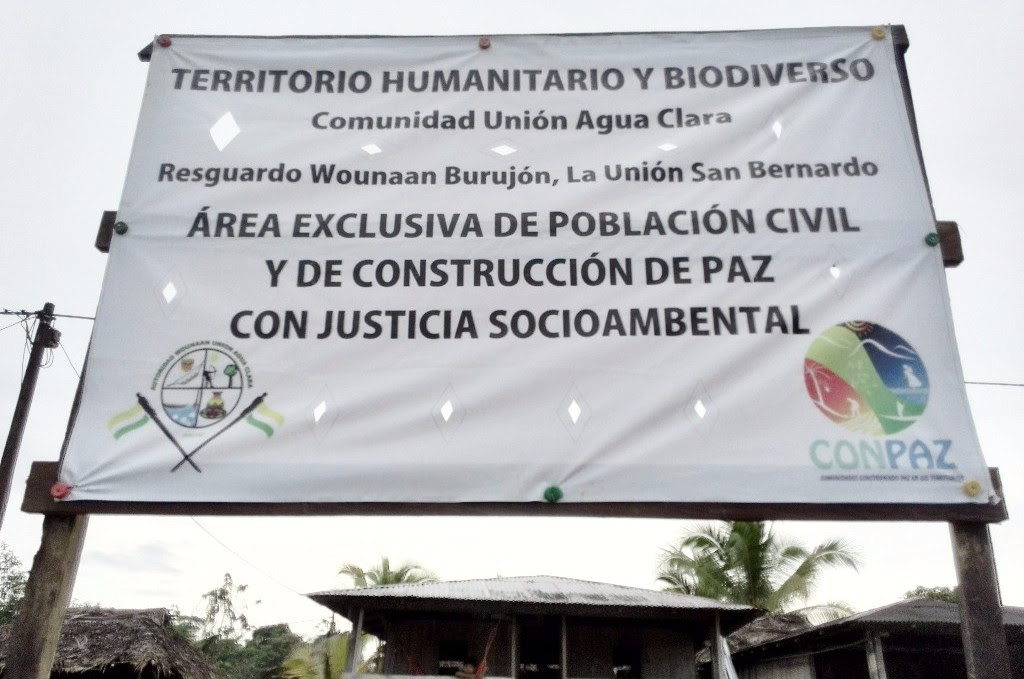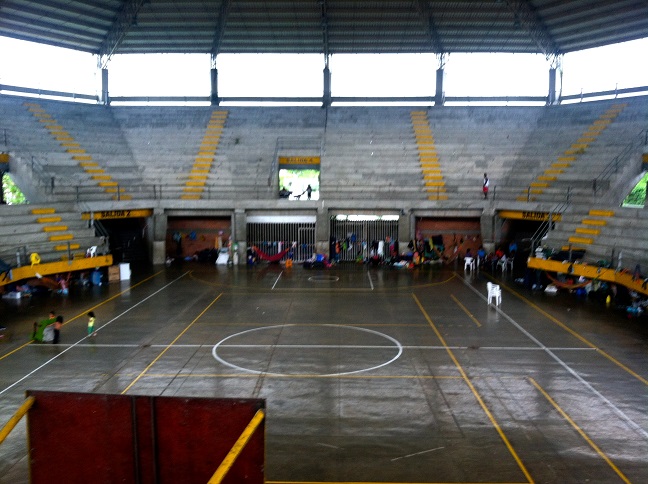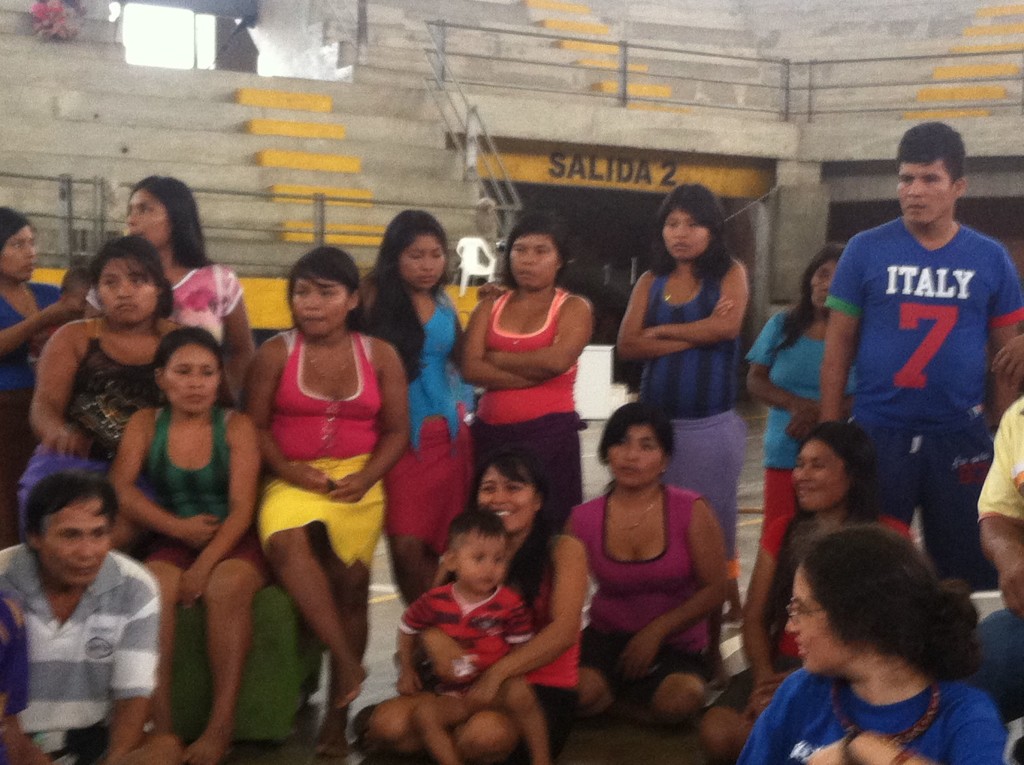By Mary Cappelli
Featured image: Wounaan Banner, reading:
Humanitarian and biodiverse territory
Community of Union Aguas Claras
Reservation of Wounaan Burujon, La Union San Bernardo
An exclusive area of civilians and peacebuilding and justice
The Wounaan Tribe of Northwestern Colombia’s San Juan River is the latest casualty of a violent 25 year reign of terror hastened by the convergence of coca growers, gold miners, paramilitaries, guerillas, and government troops—all vying for control of the waterways and resources along the ancestral stretch of traditional Wounaan territories. Until the arrival of mono-crop production for export, Wounaan’s steadfast strategies have thwarted the bloodied battlefields of Spanish colonial impositions, nationalist armies, and Marxist guerrillas.
Occupying small thatched huts stilted on posts hovering up to eight feet high along the clearings on the riverbanks, the Wounaan kept to their subsistence livelihoods of hunting, fishing, Werregue Palm basket-weaving, and small-scale agriculture of bananas, pineapples, and yucca. That is until November 2014 when the Wounaan Tribe was forced to leave their village of Unión Aguas Claras along the San Juan river of the Cauca Valley and take up a 12-month residence in El Cristal Sports Arena in Buenaventura, Colombia.
According to Wounaan spokesman Crelo Obispo, “Paramilitaries kicked us out of land” and for twelve months they worked diligently to “find a peaceful way to recover our own indigenous land.” The Wounaan turned their occupation into a form of civil disobedience and refused to return to their lands without adequate protection and security from warring factions. Although on November 29, 2015, they returned home along the San Juan River, their cultural survival signals a critical humanitarian and environmental emergency in which indigenous people living sustainable lives have been caught in a resource war for coca cultivation, gold mining and control of key river tributaries.
Occupy El Cristal
For a full year, 343 Wounaan people, 63 families, occupied the cold hard floor of the basketball courts sleeping in multi-colored hand-woven hammocks strung beneath the stadium bleachers. One of them was a young wearied mother holding a shirtless 11 month-old infant suffering from a burning fever and bouts of diarrhea and vomiting. She recalled: “There wasn’t any medicine.” Herein lies the crisis. Not only were mothers unable to gain access to traditional herbal medicines, they were also unable to gain access to modern health care. Three somber mothers told me they were running out of adequate food and water sources. Buenaventura Officials confirmed the death of two young children, one year-old Neiber Cárdenas Pirza in December 2014 and a two day-old baby in June 2014. The Wounaan claimed the deaths were a result of inadequate health care and living conditions in the sports arena. “Our people practice culture, artistry, spirituality and traditional medicine. We need our lands to do so,” said Obispo.
The affirmative belief that the Wounaan were “occupying” the sports arena and taking a political stand against their dispossession by violence is key to understanding Wounaan resistance. “We arrived November 28, 2014 and since that time we had been in resistance,” Chama Puto said. Because the “the local government hardly did anything, and gave no guarantees of assistance,” he urgently called on international help and social advocacy networks to “get meetings with entities who could make change” and affirmed Wounaan ancestral ties to their lands. “Land doesn’t belong to the government or police. It belongs to the indigenous,” he added.
The occupation of El Cristal is an example of how Indigenous peoples enact visibly distinctive resistance tactics to draw political and social mobilization to defend their right to living in their native territories. Although Wounaan Leaders such as Chama Puto are well versed in Colombia’s constitutional law, they are fully aware of how constitutional decrees have remained rhetorical discourses because of the government’s failure to implement constitutional protections within its infrastructure—an absence of institutional support that has undermined the visionary purpose of the protections. In particular, Article 63 states: “Communal lands of ethnic groups and reservation lands cannot be taken away or attached”; Article 72 states: “Ethnic groups settled in areas of archeological treasures have special rights over that cultural heritage, which rights must be regulated by law”; Article 246 provides that “the authorities of the indigenous peoples may exercise jurisdictional functions within their territories, in accordance with their own standards and procedures, provided they do not conflict with the Constitution and laws of the Republic.”
While in some cases, legal maneuvering and mobilization within Colombian Courts have served to defend indigenous landholdings, the year-long Wounaan occupation of El Cristal is a blatant recognition of the ineffectiveness of Colombia’s legislation and juridical processes. Innovative forms of resistance appeal to wider socio-political networks capable of eliciting support across local, regional, national and global borders; however, it comes with a price.
Rhizomic World
El Cristal Sports Arena was a far cry from the Wounaan’s rhizomic world of heterogeneity and its interconnected relations of all plant, animal, ancestral and human life living within its ecosystems. This dynamic cartography of interconnected networks mapped across their ancestral rhizomic river systems and landscape moves beyond western metaphysical notions of duality to foster a cosmos of inter-being. Wounaan livelihood and well-being rely on their interaction with their landscape, an animistic ethno-geographic interaction grounded in rhizomic thought in which “any point of a rhizome can be connected to anything other, and must be” (Delueze and Guattari 1988).
These beliefs further their kinship networks across time and space in a continuous state of growth in which identities and relationships extend and merge through a web of intersecting relationships. Bill Ashcroft explains the rhizome in biological imagery as multiplying “root system which spreads across the ground” from varying points reaching out across the nomadic space “rather than a single tap root” (1999).
For the Wounaan, the San Juan River is an essential organizing principle of their rhizomic networking system, rich in its biodiversity in which their cosmology interconnects them to 8000-9000 vascular plants, 577 bird species, 52 snake species, 45 lizard and allied species and 127 amphibian species—all inter-being in an ecosystem without hierarchies. In addition to its cohesive social networks, the San Juan River is the true river (döchaar) and ancestral homeland and thus a material feature in the development of their worldview and their perceptions of themselves (Velásquez Runk 2005).
The fluvial systems crisscross over a three-dimensional topography, which includes portals underworld, the real world and the celestial world. In this way their river-dominated cosmos reflects the comings and goings on the river up (marag), down (badag), to (jerag), and from (durrag) in a world where spirits, beings, plants and animals in the visible and invisible world live in a balance of reciprocal equilibrium (Velásquez Runk 2005).
Because of their metaphysical approach which links native individualities, political strategies, and traditional subsistence practices they have been able to maintain their traditional livelihoods and ways of being against the onslaught of land dispossession and acculturation (Velasco 2011). Although their rhizomic community is resistant to rupture where it has fissured and peoples are deterritorialized, the river’s organic networking systems have been capable of reattaching the Wounaan to people, plants, animals within its extended network or creating new connections across its geographical space (Kamash 2008).
Since the 1990s, the San Juan River’s fluvial systems have become reconfigured spaces in which flows of capital, commodities and contraband have brought in a host of nonlocal actors vying for spatial control of its strategic geographies. These vital commercial river networks, which connect the Colombian interior with the Pacific Coast are needed for the production and transportation of gold mining excavation and cocoa cultivation turning the once-peaceful rhizomic ecosystem into a bloody battleground between narco traffickers, gold minders, the FARC, the ELN, the Urabeños, the Rastrojos, and other left wing, right wing, and neo-paramilitary forces.
The result is not only the displacement of indigenous peoples and the disruption of the natural equilibrium of the Wounaan subsistent lifestyle, but the destruction of the biodiverse habitat in which its diverse resources have been transformed to commercial assets and mobilized for monocrop and gold production of surplus value. Added to the actors competing for resources is the introduction of new players from the National Development Plan hoping to position the San Juan River as a key geographic territory for the neoliberal exploitation of resources for free trade agreements. Dispossession for capitalist production has more importantly led to the desecration of ancestral homelands in which families are increasingly intimidated, disappeared and butchered by a collusion of local and nonlocal actors to expedite commodity commerce.
“The government said we are something in the way of development,” said Crelo Obispo further noting, “We’ve been attacked by our conqueror.” Another Wounaan spokesman added, “They want to exterminate us.” Whether it is death by paramilitary, death by narco trafficker, or death in the crossfire between guerillas and the army, there is one certainty as Crelo Obispo declares: There return to their homeland is precarious and must be “met with protection and dignity.”
Amidst these conditions are ongoing negotiations for a bilateral ceasefire between the Government and FARC. Although the Colombian government and FARC rebels have moved towards a comprehensive plan to end an ongoing civil war which, since 1964 has killed 220,000 people, the Wounaan have still been left out in the cold (Rodzinsky). Chama Puto points out that while they are negotiating in Havana, Cuba, “we had been ignored in all negotiation processes.” He believes that conflict resolution can result only when “the government negotiates with all its people.”
As of today, this has not happened and the people the color of the soil who turned their displacement into a political strategy of indigenous resistance to the destruction of their traditional ecosystems still struggle for survival. Chama Puto wants a governmental guarantee of protection and safety in order to survive on their ancestral lands. “We are done negotiating,” he said.
Forceful dispossession underpins the plight of the Wounaan whose homeland has been drained by capital’s international reach for resources in which a “free market exchange relies on and takes advantage of the political and cultural dispossession of certain subjects” (Hennessey 2013). How do indigenous people who make up two percent of Colombia’s population coexist in a global world that renders them disposable, inhuman beings? In this scenario, the two percent making up the indigenous groups of Colombia become eight percent of the dispossessed, displaced, and destined to misery as a form of “human waste”; sadly, a myth narrated and played out in the many parts of the globe.
In El Cristal, the Wounaan were separated from their means of subsistence and vigorously resisted all paradigms of commercial expansion and regional control of their economies—a pattern in which, “more than 5.7 million people have been internally displaced in Colombia since the start of recording official cumulative registration figure” (UNHRC 2015). As of 2014, Colombia’s National Victims’ Unit documented 97,453 cases of forced displacement, mostly along the Pacific region. The El Cristal crisis exposed the systematic layers of political collusion that render Wounaan territories disposable sites of exploitation and economic casualties, which dispossess its peoples from their traditional livelihoods for the benefit of both regional, national, and global markets.
Wounaan Resistance Strategies
Wounaan resistance strategies date back to colonization and manifested in their traditional tactics they implemented to maintain their sense of cultural dignity during their resistance campaign. While living in the Sports Arena women practiced small-scale artesanías in the form of colorful bracelets, necklaces, earrings, and small-carved wooden bowls. The unbroken practice of these customs created communal solidarity and furthered their economic livelihoods, traditional knowledge, and cultural sustainability (Velasco 2012). Although these courageous women were proud to sell their artisans to sports arena visitors, the transactions were soured by the reality of their dispossession. “Collectively and physically the living conditions” were “inadequate, the food inadequate.”
Wounaan resilience to reattach itself to its rhizomic rivers network is precarious and subject to intra-institutional support of regional and national control. It is yet to be seen if this latest mobilization strategy will provide any safeguards and protections for their community. “Promises have been unfulfilled and we have become strangers to ourselves,” sighed a wearied Obispo.
For more information, see CONPAZ.
References
Ashcroft, Bill (1999). “The Rhizome of Post-colonial Discourse” in Roger Luckhurst and Peter Marks (eds.) Literature and the Contemporary: Fictions and Theories of the Present, London: Longman pp. 111-125.
Deleuze, Giles, and Felix Guattarri (2007). A Thousand Plateus: Capitalism and Schizophreina. Brian Massumi, trans. Minneapolis; University of Minnesota Press.
Colombia, Información sobre Derechos Humanos y Libertades Fundamentales de la Poblaciones Indígenas presentada por el Gobierno. (Published in UN.E/CN.4/ Sub.2/AC.4/1991/4).
Hennessy, Rosemary. Fires on the Border. Hennessy, Rosemary. Fires on the Border: The Passionate Politics of Labor Organizing on the Mexican Frontera. Minneapolis: University of Minnesota Press, 2013. Print.
Kamash, Zena (2008). What Lies Beneath? Perceptions of the Ontological Paradox of Water, World Archeology 40 (2) 224-237).
Velasco, Marcela (2011). “Contested Territoriality: Ethnic Challenges to Colombia’s Territorial Regimes.” Bulletin of Latin American Research 30 (2): 213–228.
Brodzinsky, Sibylla. “ Colombia’s government and Farc rebels reach agreement in step to end civil war.” The Guardian. 15 Dec. 2015.
Runk, Julie Valasquez. (2005). And the Creator Began to Carve Us of Cocobolo: Culture, History, Forest Ecology, and Conservation among Wounaan in Eastern Panama. PhD dissertation, Department of Anthropology and the School of Forestry and Environmental Studies, Yale University and the New York Botanical Garden.
__________. (2009). Social and River Networks for the Trees: Wounaan’s Riverine Rhizomic Cosmos and Arboreal Conservation. American Anthopologist 111(4).
2015 UNRCR Country Operations Profile-Colombia. The UN Refugee Agency.







Read this piece. Cappelli’s work always fascinates and this piece doesn’t disappoint. The spirit and sheer fortitude of the Wounaan people will move you deeply. Amazing what people can do when they come together to fight for what’s right; yet possibly even more amazing that sometimes that’s not enough.
Great article on how indigenous peoples enact solidarity to combat the many political actors trying to squeeze them off their lands.
Interesting exploration of resistance. Good to hear these families are back home.
What an eye opening, insightful article spotlighting the disastrous plight of the Wounaan tribe being forced from their land – and thus their life’s blood- by a myriad of modern forces. Capelli takes an ultra- complex issue and gives it a beating heart.
This informative article reminds us of intricately we were created to cohabit the planet with all of God’s creations.